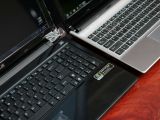Back in late 2008, Santa Clara, California-based NVIDIA surprised everybody with the launch of a new product aimed specifically at the low-end netbook and nettop market. The NVIDIA ION was widely acclaimed as one of the outfit's most interesting products, as it basically enabled OEMs to create low-priced PCs that offered better graphics, compared with what Intel's Atom platform was capable of. At that time, there was a wide media coverage of the new solution, generating enough hype for users to really want ION inside their low-power systems. Since its launch, ION has grown, as NVIDIA is planning the launch of this technology's second generation, making an effort to gain more on the portable PC market. This is where the Optimus technology comes into play, enabling NVIDIA to boost its business.
Optimus comes as an evolution, out of something that NVIDIA has kicked off with its Switchable graphics technology, back in 2007. In the words of the company's Igor Stanek, this is probably the most important mobile launch that NVIDIA has come up with. And with good measure. Optimus will basically enable users to take better advantage of the balance between the GPU and CPU, in terms of performance and battery life.
Although some saw it as a cool technology, NVIDIA's switchable graphics had one main drawback, namely that it required the end-user to choose which graphics solution they wanted to use. In addition, the technology wasn't exactly cheap, which made it less affordable to the mainstream market and available only in some expensive systems, from the likes of Sony. Although the technology evolved, switching between a discrete GPU and an integrated graphics chip wasn't really as smooth as some would have desired. Moreover, according to NVIDIA's research, less than 1% of users ever switched between IGP and the dGPU, and that's because of the way the technology enabled users to do that.
This is where Optimus comes into play, changing the way notebook graphics will work. While the previous technology required the user to manually change what GPU to use, Optimus does that while the computer is running and without the user even knowing it. Optimus decides when to switch to the discrete graphics, depending on what the end-user does. When the system is running low-graphics applications, such as Internet browsing, email or playing Solitaire, the laptop will utilize the integrated GPU, saving battery life. However, when the user decides to employ a graphics-demanding application, the system switches to the discrete GPU.
The genius behind Optimus is that it will enable NVIDIA to be inside Intel-powered laptops, without having to worry about licensing problems. And that's big, if you consider the huge market share that Intel has, in the mobile space. In addition, it also helps NVIDIA dominate AMD in the notebook space, as this technology is currently available only for Intel processors. That said, you should get a pretty general idea of how the much-anticipated ION 2 platform will work.
We will soon be putting the technology through its paces, as ASUS has been fast to adopt the new solution and has made it available in some of its latest laptops. We will further discuss what Optimus is all about, in a future article, but, until that time, we should note that NVIDIA expects about 50+ design wins to be made official this summer. If all things go smoothly for NVIDIA, Optimus should be greater than ION.

 14 DAY TRIAL //
14 DAY TRIAL // 

